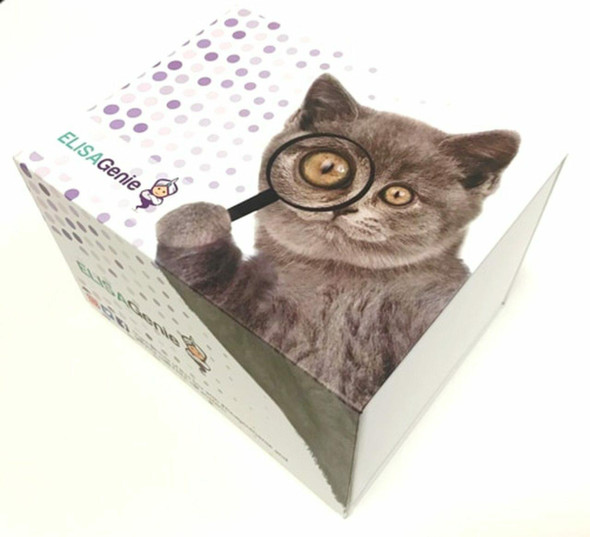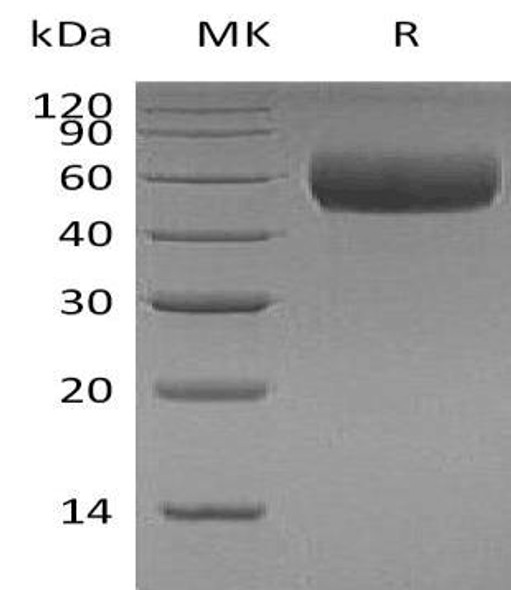Human Cell Biology ELISA Kits 3
Human ApoH (Apolipoprotein H) CLIA Kit (HUES00339)
- SKU:
- HUES00339
- Product Type:
- ELISA Kit
- ELISA Type:
- CLIA Kit
- Size:
- 96 Assays
- Sensitivity:
- 46.88pg/mL
- Range:
- 78.13-5000pg/mL
- ELISA Type:
- Sandwich
- Reactivity:
- Human
- Sample Type:
- Serum, plasma and other biological fluids
- Research Area:
- Cell Biology
Description
| Assay type: | Sandwich |
| Format: | 96T |
| Assay time: | 4.5h |
| Reactivity: | Human |
| Detection method: | Chemiluminescence |
| Detection range: | 78.13-5000 pg/mL |
| Sensitivity: | 46.88 pg/mL |
| Sample volume: | 100µL |
| Sample type: | Serum, plasma and other biological fluids |
| Repeatability: | CV < 15% |
| Specificity: | This kit recognizes Human ApoH in samples. No significant cross-reactivity or interference between Human ApoH and analogues was observed. |
This kit uses Sandwich-CLIA as the method. The micro CLIA plate provided in this kit has been pre-coated with an antibody specific to Human ApoH. Standards or samples are added to the appropriate micro CLIA plate wells and combined with the specific antibody. Then a biotinylated detection antibody specific for Human ApoH and Avidin-Horseradish Peroxidase (HRP) conjugate are added to each micro plate well successively and incubated. Free components are washed away. The substrate solution is added to each well. Only those wells that contain Human ApoH, biotinylated detection antibody and Avidin-HRP conjugate will appear fluorescence. The Relative light unit (RLU) value is measured spectrophotometrically by the Chemiluminescence immunoassay analyzer. The RLU value is positively associated with the concentration of Human ApoH. The concentration of Human ApoH in the samples can be calculated by comparing the RLU of the samples to the standard curve.
| UniProt Protein Function: | APOH: Binds to various kinds of negatively charged substances such as heparin, phospholipids, and dextran sulfate. May prevent activation of the intrinsic blood coagulation cascade by binding to phospholipids on the surface of damaged cells. |
| UniProt Protein Details: | Protein type:Secreted; Lipid-binding; Secreted, signal peptide Chromosomal Location of Human Ortholog: 17q24. 2 Cellular Component: extracellular matrix; extracellular space; chylomicron; cell surface Molecular Function:heparin binding; identical protein binding; protein binding; phospholipid binding; glycoprotein binding; lipid binding Biological Process: negative regulation of angiogenesis; negative regulation of myeloid cell apoptosis; triacylglycerol metabolic process; positive regulation of blood coagulation; negative regulation of fibrinolysis; negative regulation of endothelial cell proliferation; positive regulation of lipoprotein lipase activity; negative regulation of blood coagulation; triacylglycerol transport; blood coagulation, intrinsic pathway; plasminogen activation; regulation of fibrinolysis |
| NCBI Summary: | Apolipoprotein H has been implicated in a variety of physiologic pathways including lipoprotein metabolism, coagulation, and the production of antiphospholipid autoantibodies. APOH may be a required cofactor for anionic phospholipid binding by the antiphospholipid autoantibodies found in sera of many patients with lupus and primary antiphospholipid syndrome, but it does not seem to be required for the reactivity of antiphospholipid autoantibodies associated with infections. [provided by RefSeq, Jul 2008] |
| UniProt Code: | P02749 |
| NCBI GenInfo Identifier: | 543826 |
| NCBI Gene ID: | 350 |
| NCBI Accession: | P02749. 3 |
| UniProt Secondary Accession: | P02749,Q9UCN7, B2R9M3, |
| UniProt Related Accession: | P02749 |
| Molecular Weight: | 345 |
| NCBI Full Name: | Beta-2-glycoprotein 1 |
| NCBI Synonym Full Names: | apolipoprotein H (beta-2-glycoprotein I) |
| NCBI Official Symbol: | APOH |
| NCBI Official Synonym Symbols: | BG; B2G1; B2GP1 |
| NCBI Protein Information: | beta-2-glycoprotein 1; B2GPI; apo-H; beta(2)GPI; APC inhibitor; anticardiolipin cofactor; activated protein C-binding protein |
| UniProt Protein Name: | Beta-2-glycoprotein 1 |
| UniProt Synonym Protein Names: | APC inhibitor; Activated protein C-binding protein; Anticardiolipin cofactor; Apolipoprotein H; Apo-H; Beta-2-glycoprotein I; B2GPI; Beta(2)GPI |
| Protein Family: | Beta-2-glycoprotein |
| UniProt Gene Name: | APOH |
| UniProt Entry Name: | APOH_HUMAN |
As the RLU values of the standard curve may vary according to the conditions of the actual assay performance (e. g. operator, pipetting technique, washing technique or temperature effects), the operator should establish a standard curve for each test. Typical standard curve and data is provided below for reference only.
| Concentration (pg/mL) | RLU | Average | Corrected |
| 5000 | 57436 65076 | 61256 | 61233 |
| 2500 | 33352 35356 | 34354 | 34331 |
| 1250 | 18907 17431 | 18169 | 18146 |
| 625 | 8972 9812 | 9392 | 9369 |
| 312.5 | 4854 4812 | 4833 | 4810 |
| 156.25 | 2557 2465 | 2511 | 2488 |
| 78.13 | 1246 1432 | 1339 | 1316 |
| 0 | 23 23 | 23 | -- |
Precision
Intra-assay Precision (Precision within an assay): 3 samples with low, mid range and high level Human ApoH were tested 20 times on one plate, respectively.
Inter-assay Precision (Precision between assays): 3 samples with low, mid range and high level Human ApoH were tested on 3 different plates, 20 replicates in each plate.
| Intra-assay Precision | Inter-assay Precision | |||||
| Sample | 1 | 2 | 3 | 1 | 2 | 3 |
| n | 20 | 20 | 20 | 20 | 20 | 20 |
| Mean (pg/mL) | 247.79 | 574.87 | 1815.52 | 242.73 | 613.72 | 1782.40 |
| Standard deviation | 30.08 | 59.44 | 204.79 | 26.34 | 45.11 | 159.35 |
| C V (%) | 12.14 | 10.34 | 11.28 | 10.85 | 7.35 | 8.94 |
Recovery
The recovery of Human ApoH spiked at three different levels in samples throughout the range of the assay was evaluated in various matrices.
| Sample Type | Range (%) | Average Recovery (%) |
| Serum (n=5) | 88-101 | 94 |
| EDTA plasma (n=5) | 88-100 | 93 |
| Cell culture media (n=5) | 94-111 | 102 |
Linearity
Samples were spiked with high concentrations of Human ApoH and diluted with Reference Standard & Sample Diluent to produce samples with values within the range of the assay.
| Serum (n=5) | EDTA plasma (n=5) | Cell culture media (n=5) | ||
| 1:2 | Range (%) | 86-100 | 101-115 | 95-108 |
| Average (%) | 91 | 109 | 102 | |
| 1:4 | Range (%) | 97-110 | 93-108 | 84-97 |
| Average (%) | 104 | 99 | 91 | |
| 1:8 | Range (%) | 90-105 | 103-116 | 87-103 |
| Average (%) | 96 | 109 | 94 | |
| 1:16 | Range (%) | 95-108 | 94-110 | 100-117 |
| Average (%) | 101 | 100 | 108 |
An unopened kit can be stored at 4°C for 1 month. If the kit is not used within 1 month, store the items separately according to the following conditions once the kit is received.
| Item | Specifications | Storage |
| Micro CLIA Plate(Dismountable) | 8 wells ×12 strips | -20°C, 6 months |
| Reference Standard | 2 vials | |
| Concentrated Biotinylated Detection Ab (100×) | 1 vial, 120 µL | |
| Concentrated HRP Conjugate (100×) | 1 vial, 120 µL | -20°C(shading light), 6 months |
| Reference Standard & Sample Diluent | 1 vial, 20 mL | 4°C, 6 months |
| Biotinylated Detection Ab Diluent | 1 vial, 14 mL | |
| HRP Conjugate Diluent | 1 vial, 14 mL | |
| Concentrated Wash Buffer (25×) | 1 vial, 30 mL | |
| Substrate Reagent A | 1 vial, 5 mL | 4°C (shading light) |
| Substrate Reagent B | 1 vial, 5 mL | 4°C (shading light) |
| Plate Sealer | 5 pieces | |
| Product Description | 1 copy | |
| Certificate of Analysis | 1 copy |
- Set standard, test sample and control (zero) wells on the pre-coated plate and record theirpositions. It is recommended to measure each standard and sample in duplicate. Note: addall solutions to the bottom of the plate wells while avoiding contact with the well walls. Ensuresolutions do not foam when adding to the wells.
- Aliquot 100µl of standard solutions into the standard wells.
- Add 100µl of Sample / Standard dilution buffer into the control (zero) well.
- Add 100µl of properly diluted sample (serum, plasma, tissue homogenates and otherbiological fluids. ) into test sample wells.
- Cover the plate with the sealer provided in the kit and incubate for 90 min at 37°C.
- Aspirate the liquid from each well, do not wash. Immediately add 100µL of BiotinylatedDetection Ab working solution to each well. Cover the plate with a plate seal and gently mix. Incubate for 1 hour at 37°C.
- Aspirate or decant the solution from the plate and add 350µL of wash buffer to each welland incubate for 1-2 minutes at room temperature. Aspirate the solution from each well andclap the plate on absorbent filter paper to dry. Repeat this process 3 times. Note: a microplatewasher can be used in this step and other wash steps.
- Add 100µL of HRP Conjugate working solution to each well. Cover with a plate seal andincubate for 30 min at 37°C.
- Aspirate or decant the solution from each well. Repeat the wash process for five times asconducted in step 7.
- Add 100µL of Substrate mixture solution to each well. Cover with a new plate seal andincubate for no more than 5 min at 37°C. Protect the plate from light.
- Determine the RLU value of each well immediately.






